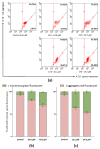Hybrids of Sterically Hindered Phenols and Diaryl Ureas: Synthesis, Switch from Antioxidant Activity to ROS Generation and Induction of Apoptosis
- PMID: 37628818
- PMCID: PMC10454409
- DOI: 10.3390/ijms241612637
Hybrids of Sterically Hindered Phenols and Diaryl Ureas: Synthesis, Switch from Antioxidant Activity to ROS Generation and Induction of Apoptosis
Abstract
The utility of sterically hindered phenols (SHPs) in drug design is based on their chameleonic ability to switch from an antioxidant that can protect healthy tissues to highly cytotoxic species that can target tumor cells. This work explores the biological activity of a family of 45 new hybrid molecules that combine SHPs equipped with an activating phosphonate moiety at the benzylic position with additional urea/thiourea fragments. The target compounds were synthesized by reaction of iso(thio)cyanates with C-arylphosphorylated phenols containing pendant 2,6-diaminopyridine and 1,3-diaminobenzene moieties. The SHP/urea hybrids display cytotoxic activity against a number of tumor lines. Mechanistic studies confirm the paradoxical nature of these substances which combine pronounced antioxidant properties in radical trapping assays with increased reactive oxygen species generation in tumor cells. Moreover, the most cytotoxic compounds inhibited the process of glycolysis in SH-SY5Y cells and caused pronounced dissipation of the mitochondrial membrane of isolated rat liver mitochondria. Molecular docking of the most active compounds identified the activator allosteric center of pyruvate kinase M2 as one of the possible targets. For the most promising compounds, 11b and 17b, this combination of properties results in the ability to induce apoptosis in HuTu 80 cells along the intrinsic mitochondrial pathway. Cyclic voltammetry studies reveal complex redox behavior which can be simplified by addition of a large excess of acid that can protect some of the oxidizable groups by protonations. Interestingly, the re-reduction behavior of the oxidized species shows considerable variations, indicating different degrees of reversibility. Such reversibility (or quasi-reversibility) suggests that the shift of the phenol-quinone equilibrium toward the original phenol at the lower pH may be associated with lower cytotoxicity.
Keywords: anticancer activity; apoptosis; cytotoxicity; electrochemical oxidation; glycolysis; mitochondrial membrane potential; molecular docking; quinone methides; sterically hindered phenol; urea.
Conflict of interest statement
The authors declare no conflict of interest.
Figures













References
-
- Yang W.Y., Breiner B., Kovalenko S.V., Ben C., Singh M., LeGrand S.N., Sang Q.X.A., Strouse G.F., Copland J.A., Alabugin I.V. C-Lysine Conjugates: PH-Controlled Light-Activated Reagents for Efficient Double-Stranded DNA Cleavage with Implications for Cancer Therapy. J. Am. Chem. Soc. 2009;131:11458–11470. doi: 10.1021/ja902140m. - DOI - PMC - PubMed
MeSH terms
Substances
Grants and funding
LinkOut - more resources
Full Text Sources
Medical

